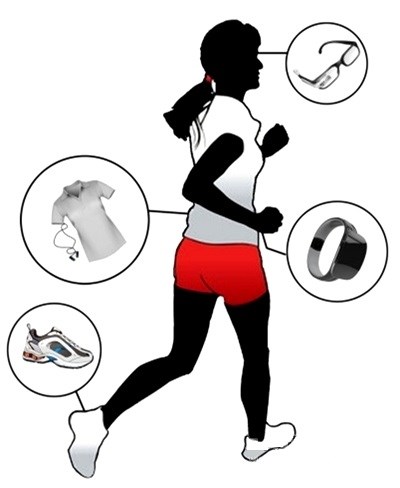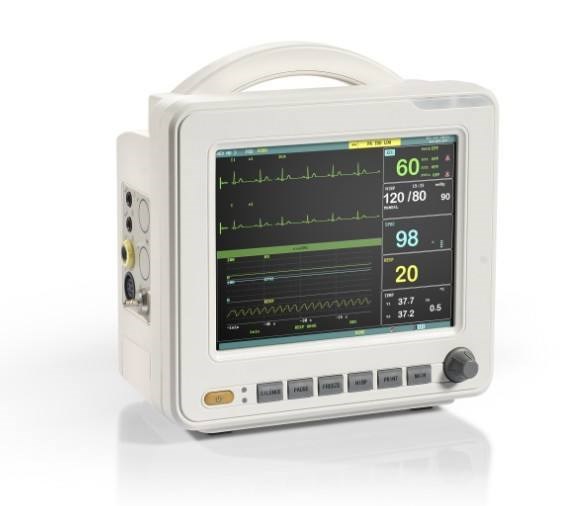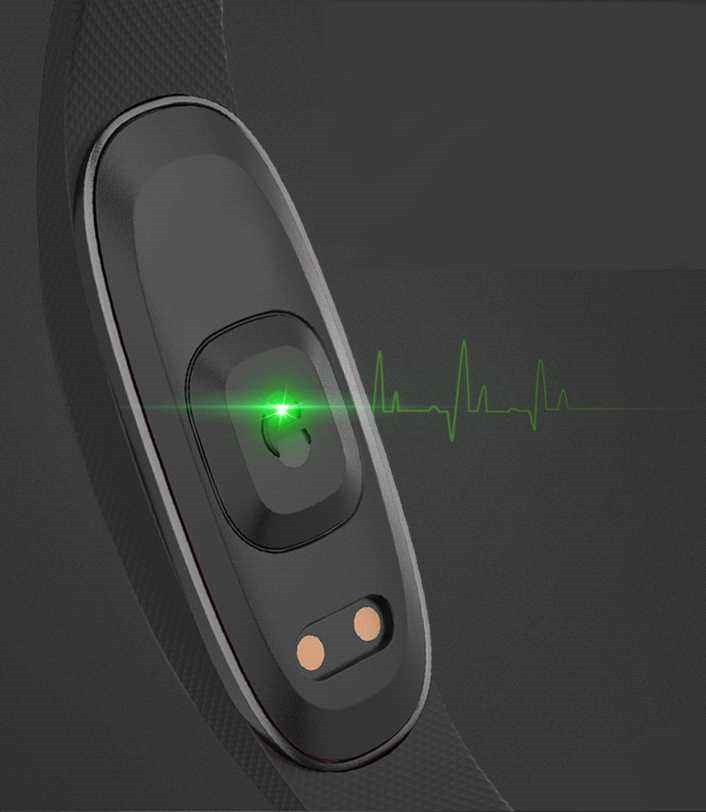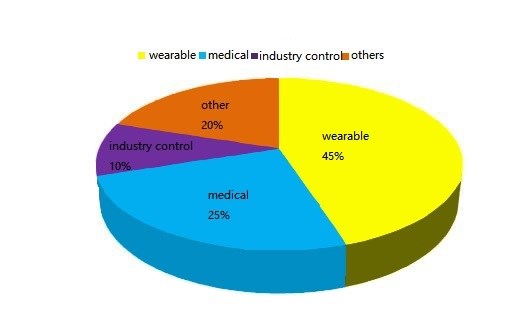Ⅰ Introduction
A wearable sensor is the core of the wearable device which is a computing device that can be installed on people, animals, and objects, and can sense, transmit, and process information. The sensor in the wearable device is an extension and enhancement of the human senses. With the development of biotechnology and the miniaturization of sensors, wearable devices may evolve into smart devices implanted in the human body. In a variety of wearable devices, there is a key device-the sensor. It can feel the changes in the external conditions, such as warm and cold, fast and slow, and respond accordingly, just like our skin.
Ⅱ Types of sensors are in wearable devices
1.Motion sensor
The motion sensor is the motion control sensor, which is a kind of original device that converts the change of non-electricity (such as speed and pressure) into the change of electric quantity. Motion sensors include acceleration sensors, gyroscopes, geomagnetic sensors, and atmospheric pressure sensors, etc.

Various wearable devices
The main functions of these sensors are motion detection, navigation, entertainment, human-computer interaction, etc. Among them, the electronic compass sensor can be used to measure the direction and realize or assist navigation. It is of great value to measure, record, and analyze the human body's activities through motion sensors anytime and anywhere. Users can know the number of running steps, the number of swimming laps, the distance traveled, energy consumption, and sleep time, and even the quality of sleep.
2.Biological sensor
A biological sensor is an instrument that is sensitive to biological substances and converts its concentration into electrical signals for detection. It is an analysis tool or system which is composed of immobilized biological sensitive materials as identification elements (including enzymes, antibodies, antigens, microorganisms, cells, tissues, nucleic acids, and other biologically active substances) and appropriate physical and chemical transducers (such as oxygen electrodes, photosensitive tubes, field-effect tubes, piezoelectric crystals, etc.) and signal amplification devices. The biological sensor can be used as a receiver and a converter.
Biological sensors include blood glucose sensors, blood pressure sensors, electrocardiogram sensors, myoelectric sensors, body temperature sensors, brain wave sensors, etc. The main functions of these sensors include health and medical monitoring, entertainment, and so on.

blood pressure sensor
Function and working principle of biological sensors
With the help of wearable technology, such as health warnings and condition monitoring, doctors can improve the diagnosis, and family members can communicate with patients better.
For example, a wearable medical device composed of blood pressure sensors can track and analyze the user's physical data. And then the wearable medical device extracts medical diagnostic models, predicts the user's health, and provides users with personalized cardiovascular special personal medical and health management programs.
The blood pressure monitor uses sensors to detect small changes in cuff pressure caused by the vibration of the arterial blood vessel wall. The most commonly used method is the oscillation method. The basic principle is to use the cuff tied to the arm and inflate the cuff by an inflator to block the propagation of pulsation in the blood vessel. When a certain pressure (generally 124 to 316 kPa) is reached, deflation begins. When the air pressure reaches a certain level, the blood flow can pass through the blood vessels, and there is a certain amount of oscillating waves. Gradually deflate, the oscillating wave gets bigger and bigger, and the contact area between the cuff and the arm becomes smaller. Therefore, the pressure and fluctuation detected by the pressure sensor are getting smaller and smaller, and the pressure sensor can detect the pressure and the fluctuation in the cuff in real-time.
The oscillating wave propagates through the trachea to the pressure sensor in the machine. Through the corresponding amplification, a filter circuit, analog/digital signal conversion, central processor control, and other processing links, it will be transmitted to the pulsation signal and pressure signal in the gas circuit through the cuff and then converted into a digital signal. Being further processed to obtain data such as systolic pressure, diastolic pressure, the average pressure of blood pressure. This ambulatory blood pressure monitor can be connected to mobile devices via Bluetooth and USB. Data will be uploaded to medical stuff. The ambulatory blood pressure monitors are usually worn by users which can provide 24-hour blood pressure monitoring.
3.Environmental sensor
Environmental sensors include a soil temperature sensor, air temperature, and humidity sensor, evaporation sensor, rainfall sensor, light sensor, wind speed and direction sensor, etc. These environmental sensors can not only accurately measure the relevant environmental information, but also can be networked with the host computer to meet the user's requirements for testing, recording, and storage of the measured object data. Environmental sensors are the preferred instruments for scientific research, teaching, laboratories, and related agricultural environmental monitoring departments.
Function and working principle of environmental sensor
In today's world, people are often exposed to health-threatening environments, such as smog and excessive indoor formaldehyde. The PM2.5 portable detector, an air quality detection device composed of particulate matter sensors, can be worn on the human body and can be displayed alone or used in conjunction with a mobile phone and shared with friends.
The PM2.5 portable test draws the aerosol to be tested into the test chamber through the gas pump dust meter. The aerosol to be tested is split into two parts at the shunt of the dust meter. One part is filtered into clean air after passing through a high-efficiency filter to protect the components of the sensor chamber from the gas to be measured. The other part of the aerosol enters the sensor chamber directly as the sample to be tested.
Particles and molecules will generate a light scattering phenomenon under the irradiation of light, and at the same time, they also absorb part of the energy of the irradiated light. When a beam of parallel monochromatic light enters the field of the particle to be measured, it will be affected by scattering and absorption around the particle, and the light intensity will be attenuated. In this way, the relative attenuation rate of incident light through the concentration field to be measured can be obtained. The relative attenuation rate can linearly reflect the relative concentration of dust in the field to be measured. The magnitude of the light intensity is proportional to the strength of the electrical signal after photoelectric conversion, and the relative attenuation rate can be obtained by measuring the electrical signal.
4.Skin electric sensor
You may have this kind of experience. When you are going to undertake a very important task, you will feel nervous, anxious and your hands and feet will sweat. This process by which psychological response is transformed into a physiological response can be detected by electrical skin sensors.
The an important part of the lie detector, but it cannot test the user's emotions. It can only feel whether the user's psychological state has changed, and through this change, we can get some conclusions. For example, the electrical sensor of the lie detector can sense the psychological change of the subject when speaking, to determine whether to lie.
For example, studies have shown that people's skin electrical response levels are low when they wake up in the morning and sleep at night, while the skin electrical level in a certain period in the morning and afternoon is relatively high, and this period is the most efficient the period when we learning or working.
5.Heart rate sensor
As a superweapon for personal health equipment, the heart rate sensor can track heart rate to track exercise intensity and can calculate the health action data associated with the sleep cycle and other data based on this data.

Smart bracelet with heart rate sensor
At present, there are two types of heart rate sensors, a photoelectric heart rate sensor measured by light reflection and an electrode type heart rate sensor that uses the potential measurement of different parts of the human body.
Although the former has poor measurement accuracy, its advantage lies in its small size, so all mobile terminals currently use this method for measurement. When the latter measures electrocardiograms in hospitals, we often see that the heart rate changes are measured by the potential changes at different points in the human body. This method measures the heart rate accurately, but it must monitor both parts of the human body at the same time.
6.Barometer
The barometer is a little thing but very useful. Although it can only measure air pressure data, we can accurately know the altitude of the machine through this data. If you monitor the changes in air pressure over some time, you can also obtain data on the height of the machine to prepare for further data processing.
With a barometer, outdoor athletes can intuitively know their altitude. The future navigation map can not only know where we are but even the floor where we are, which is an inevitable trend of future navigation development. Though the wearable device can only detect the number of steps people take each day, having a barometer can also detect the number of stairs taken, which makes the calorie consumption data more accurate.
The emergence of wearable smart devices has brought us a whole new way of life. Various functions of wearable smart devices depend on the integration and innovation of various sensor functions. Therefore, it is necessary to develop more accurate, miniaturized, and integrated sensors to meet the needs. In the future, with the continuous advancement of modern "electronics-sensor" technology, wearable devices will continue to move forward as always.
Ⅲ Advantages of wearable sensors
1.The importance of motion, environment, and biological sensors
The earliest wearable devices were simple pedometers based on three-axis acceleration sensors. Subsequently, complex devices including pressure sensors and gyroscopes soon appeared on the market. These devices enable wearable devices to identify the types of activities the wearer is participating in, such as walking, running, climbing, etc. At the same time, temperature and humidity sensors enable wearable devices to more accurately measure parameters such as calories burned during exercise.
The trend of wearable devices integrating more sensors will accelerate in the next few years. In particular, we will see more and more integrated motion and environmental sensors, as well as emerging biological sensors. Biological sensors are now used in stand-alone wearable medical monitors, and many consumer devices now offer heart rate measurement capabilities. But in the next few years, consumer devices will integrate a wider range of biological sensors, such as spectral sensors that measure blood oxygen levels, blood pressure, and blood sugar levels, and skin resistance sensors that determine sweat levels and pH.
2.Advantages of integrating more sensors
The obvious advantage of integrating more sensors is that it increases the functionality of the device so that it can measure more parameters. Besides, the accuracy of the collected data can be improved.
For example, using information from other sensors to determine the type of activity the wearer is engaged in helping to select a more appropriate algorithm to process the input information from the acceleration sensor, making activity tracking more accurate. Besides, the combination of data from many sensors enables the device to extract more useful information for users.
3.Microphone completes the functions of the wearable device
In addition to the motion, environmental, and biological sensors mentioned above, wearable devices may also increase the use of microphone sensing elements. But the purpose is not to provide more information to the wearer, but to help the device perceive its usage context to determine what information is useful to the wearer and how to best convey this information. For example, if the device hears the roar of a jet engine, it can infer that the wearer is flying, and monitor how long it has been sitting, and then adjust the recommendations for sleep and exercise to help the wearer cope with fatigue and dehydration more effectively.
Ⅳ The connection between sensors and wearable devices
The rapid development of wearable devices is inseparable from the role of sensors. Different sensors provide a large amount of rich data for the device and display the required information indicators. Wearable devices develop with the development of their integrated sensors. One of the keys to the growth of the wearable device market is sensors. Different wearable products face different users, have different purposes, and have different built-in sensors.

Sensor development accounts for the proportion of demand in various fields
The function and reliability of wearable devices are one of the most important characteristics of users. With the emergence of more and more wearable devices, users have put forward higher requirements. The size, quality, power consumption, reliability, and stability of the sensor will affect the user experience, wearing comfort, and power consumption of wearable devices. Various functions of wearable smart devices depend on the integration and innovation of various sensors.
At present, most wearable devices are very light, and the size is getting smaller and smaller. They should not only meet ergonomic design but also have requirements for reliability, power consumption, and various harsh environments. Therefore, it is necessary to develop more accurate, miniaturized, and integrated sensors to meet the demand.
Ⅴ The potential development direction of wearable sensors
In the future, the functional requirements of sensors for sensing multiple physical signals and the needs of environment-aware applications for real-time working sensor processing will continue to grow. The potential development direction of sensor technology: multi-sensor fusion; selection of sensor materials with good biocompatibility; high sensitivity at low power consumption.
First of all, wearable devices will integrate more sensors. This trend will accelerate in the next few years. People's demand for wearable devices continues to increase, which requires the integration of more sensors. The obvious advantage of integrating more sensors is that it increases the functionality of the device so that it can measure more parameters. Besides, the accuracy of the collected data can be improved.
Secondly, wearable devices need a better ergonomic design to better fit human limbs. Therefore, it is still a big challenge in the application of new materials, and the high-resolution, high-sensitivity, fast response, and low-cost manufacturing of flexible wearable electronic sensors.
Finally, the key technology for wearable devices to continuously improve the product’s battery life and reduce energy consumption is battery energy density and environmental energy. But as far as the current technology is concerned, it is not feasible to change the performance of the battery. The wearable device can only indirectly increase the life of the device by selecting a backup battery and reducing the power consumption of the sensor.
Former Apple CEO John Sculley once said: "Wearable technology will have a huge impact on daily life. We are at the starting point of the sensory revolution. Wearable devices allow passive sensors to monitor many different things."
-
Phone
18126161077 -
Wechat





